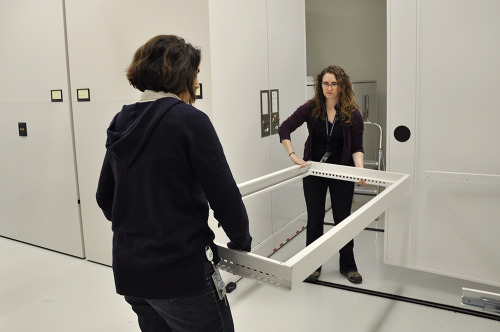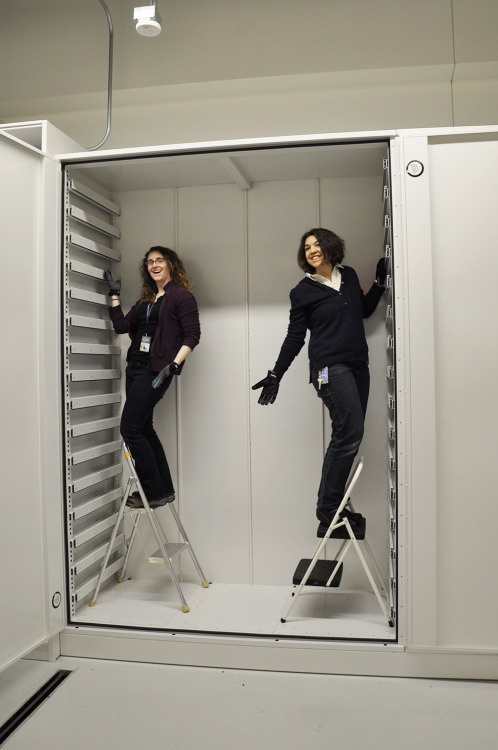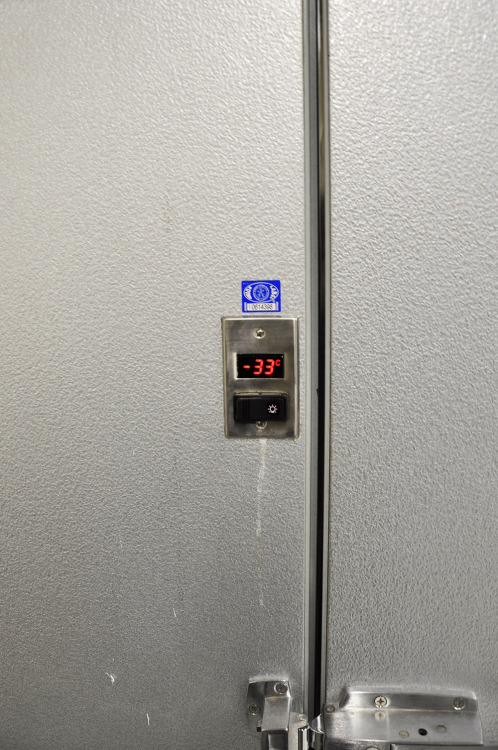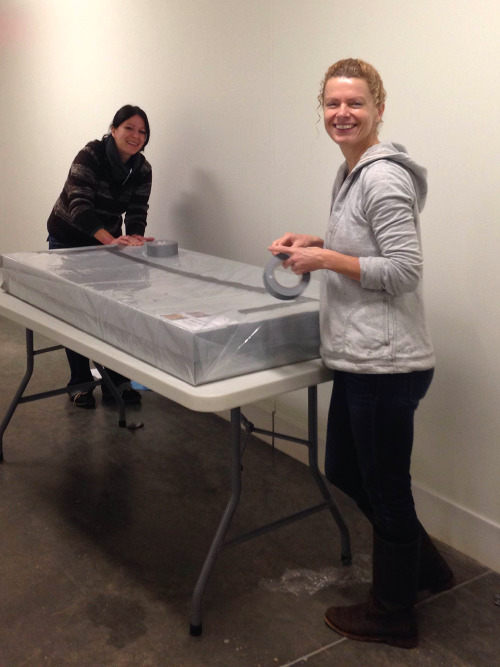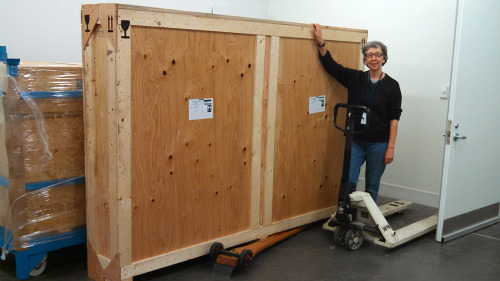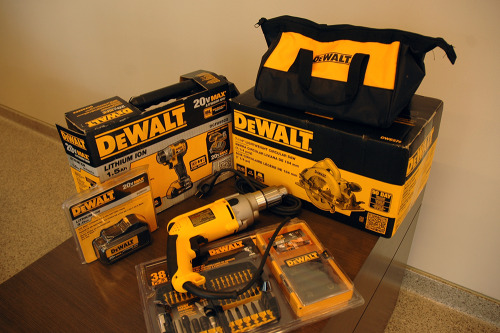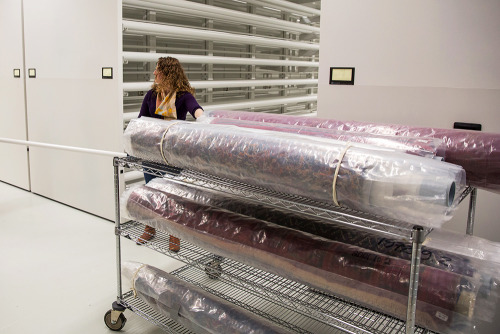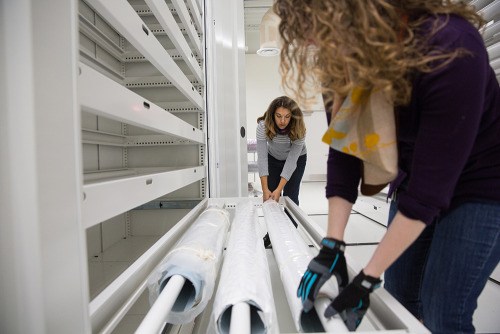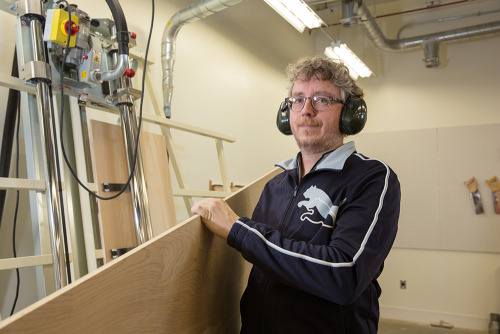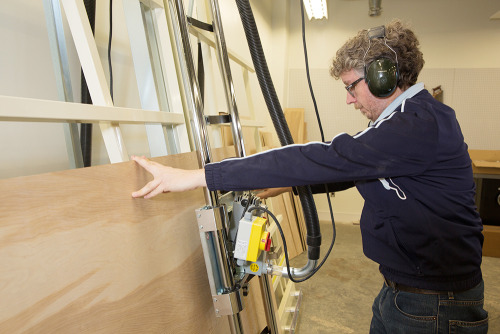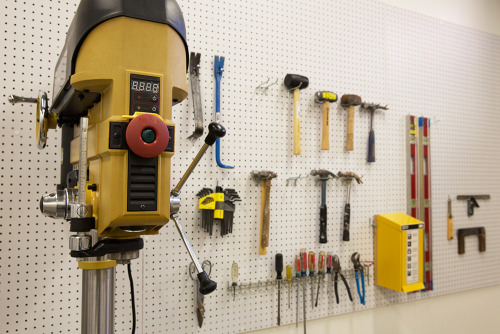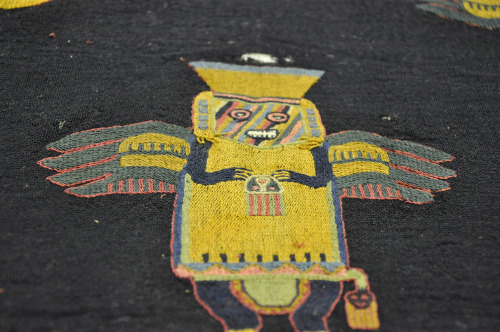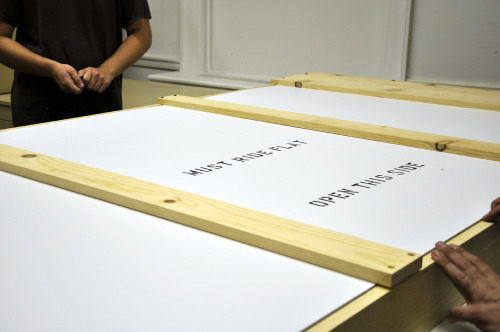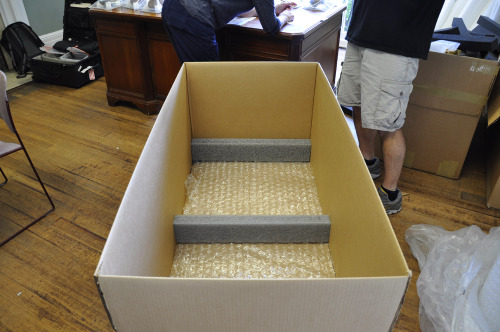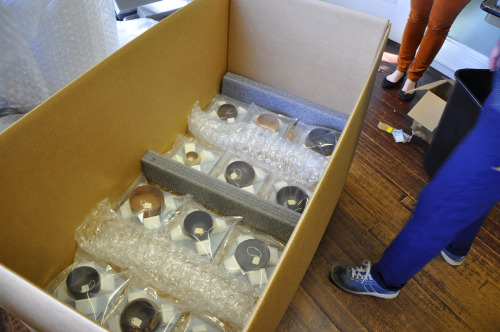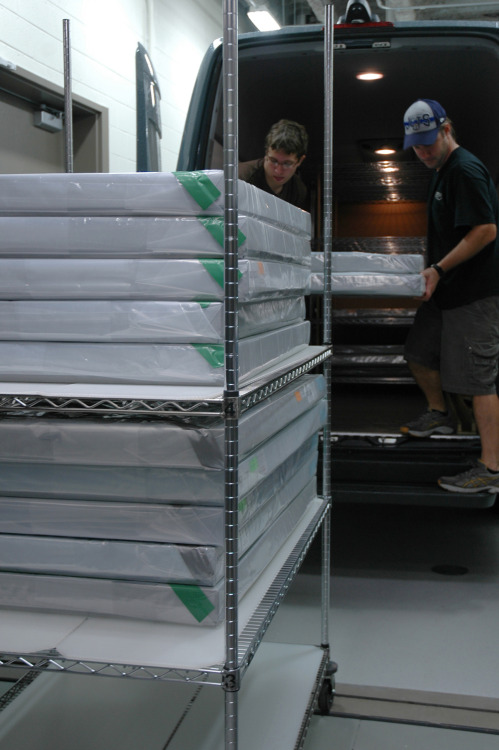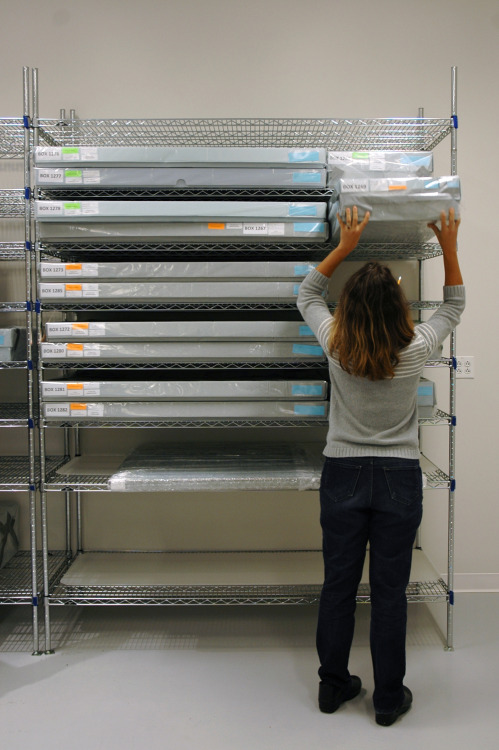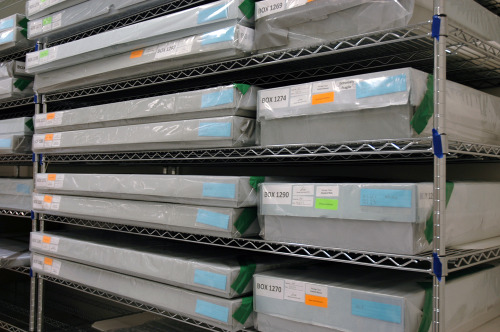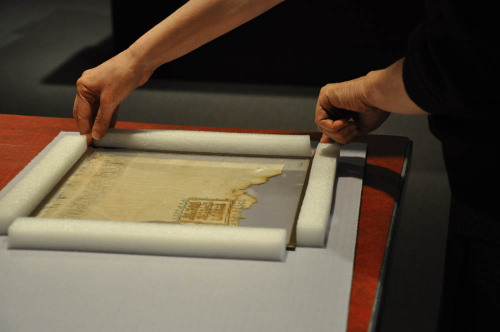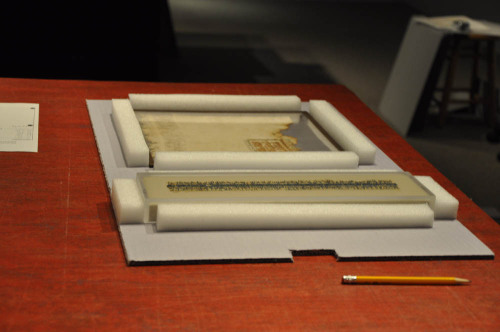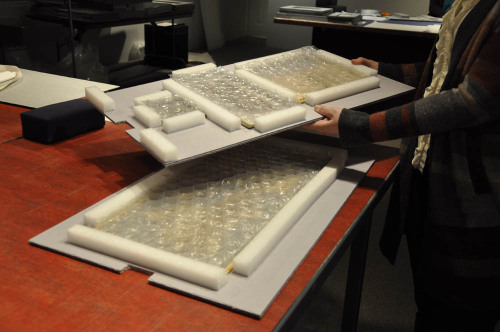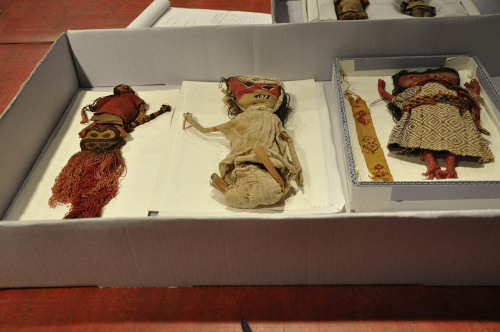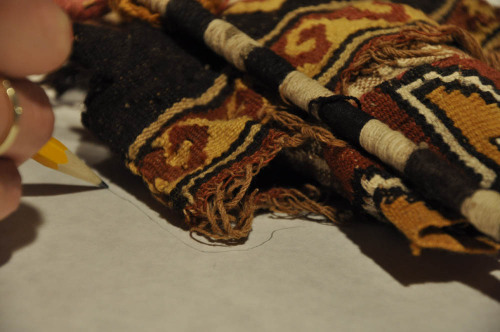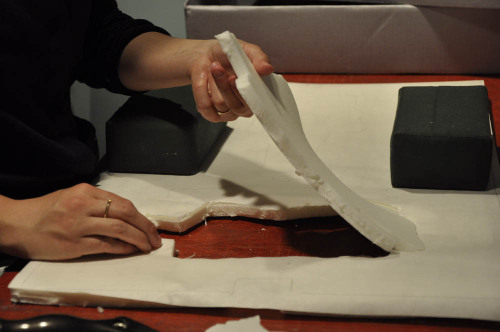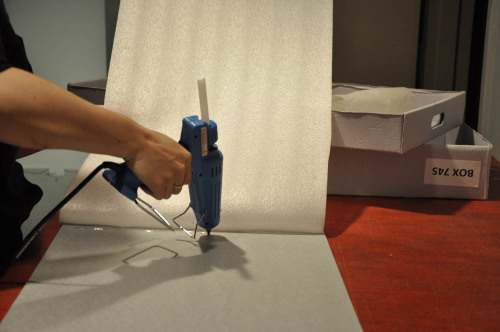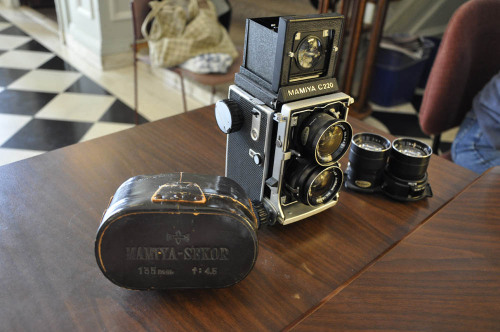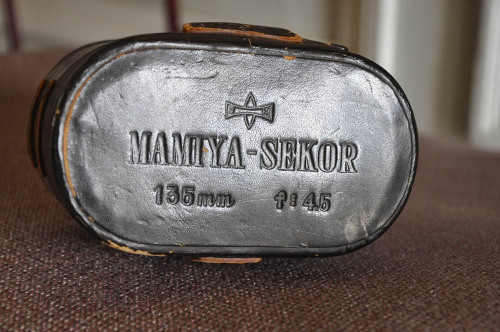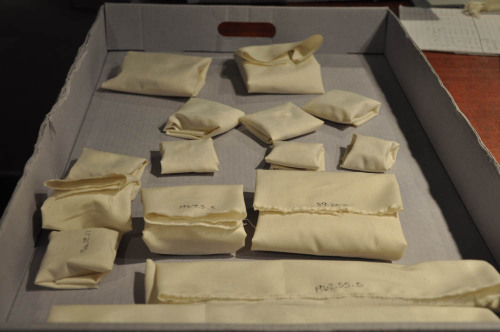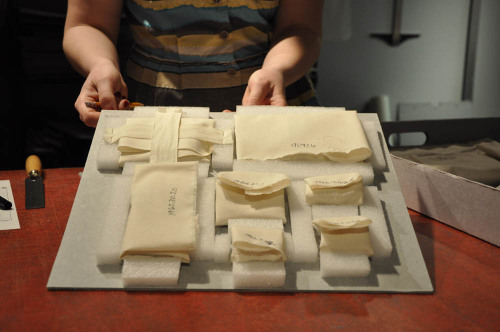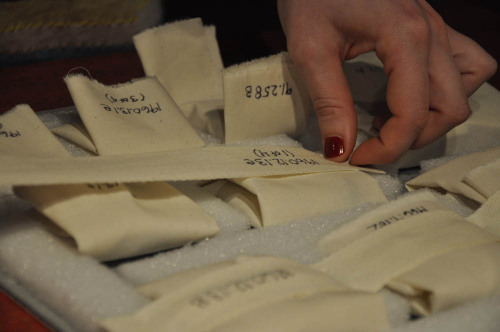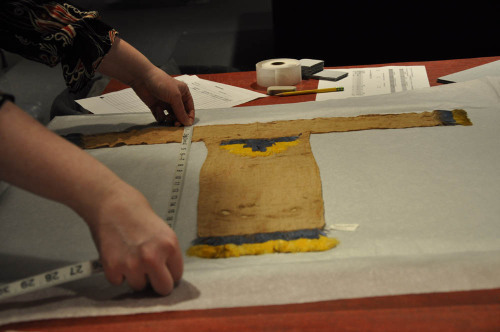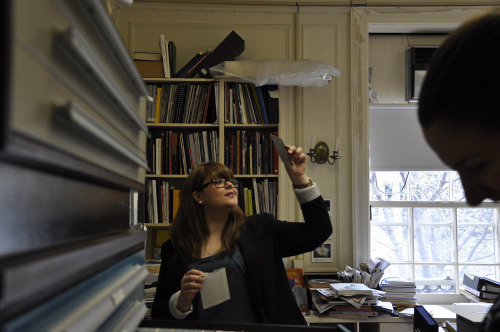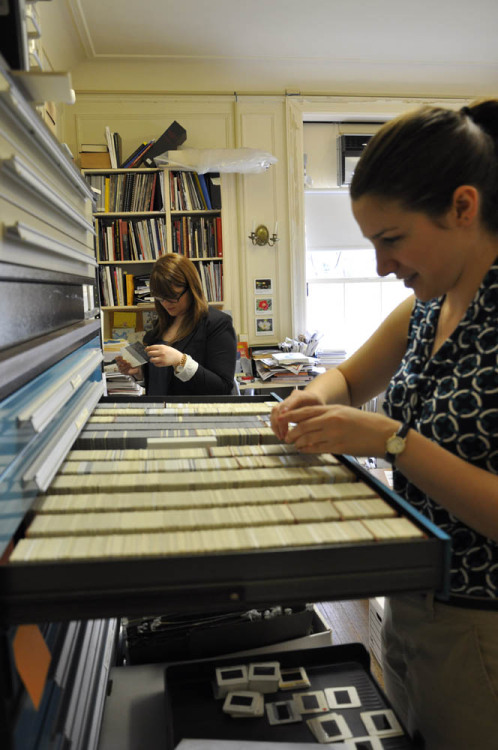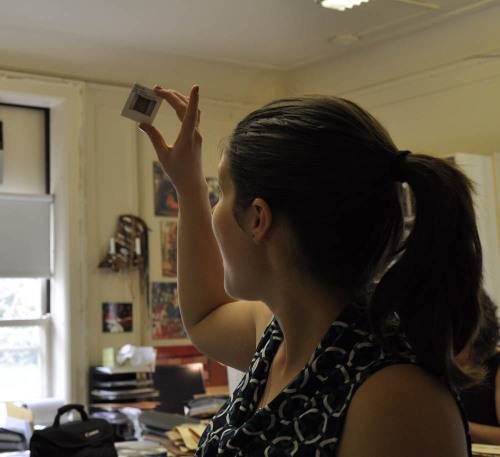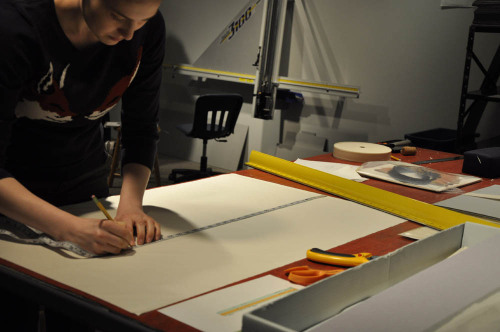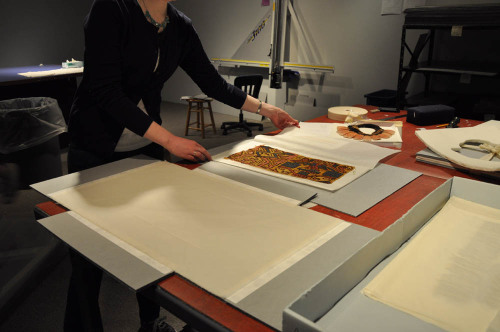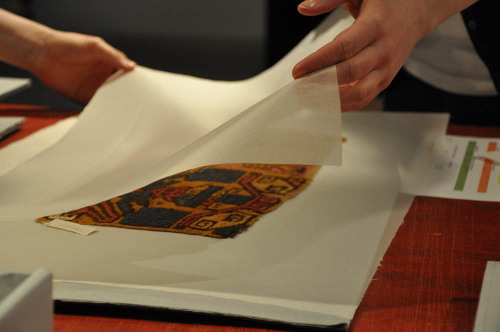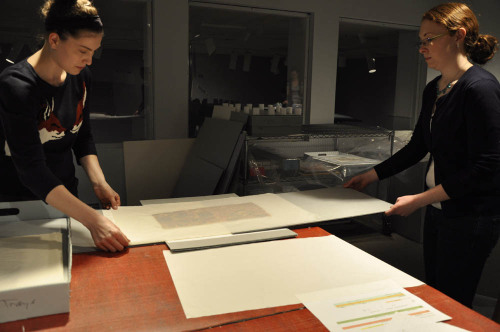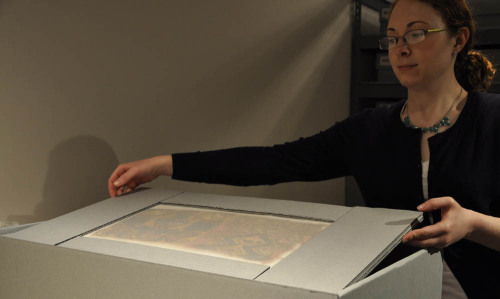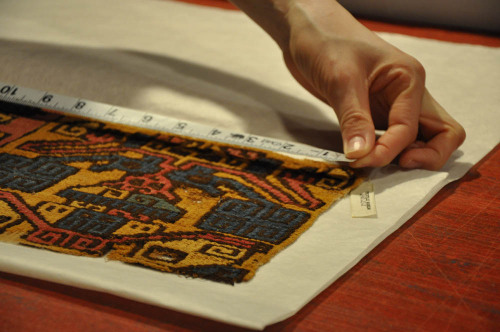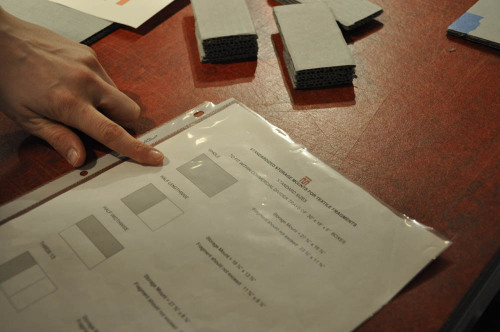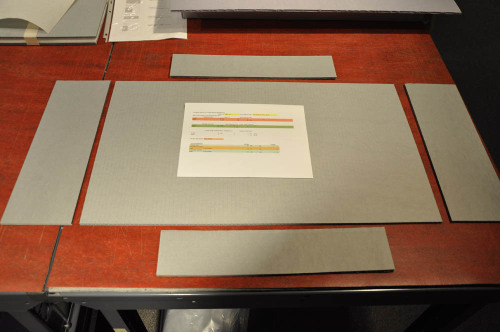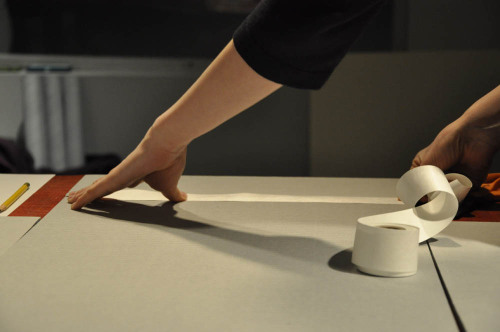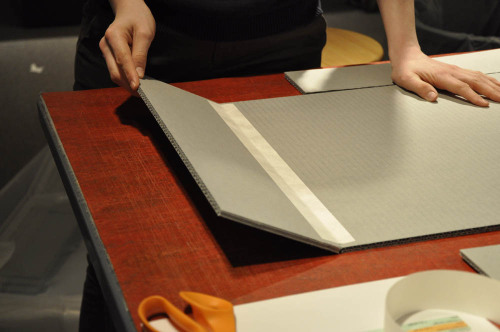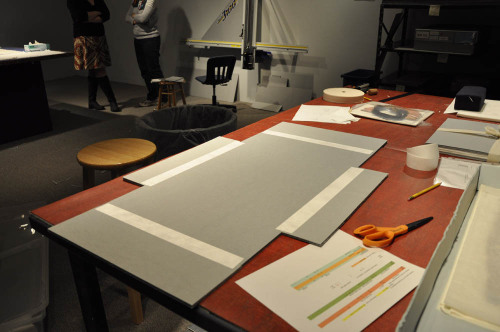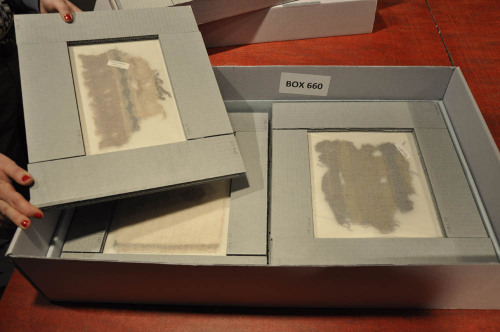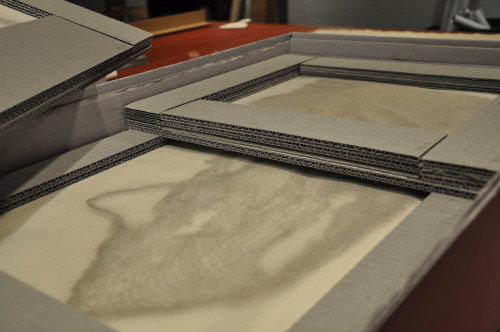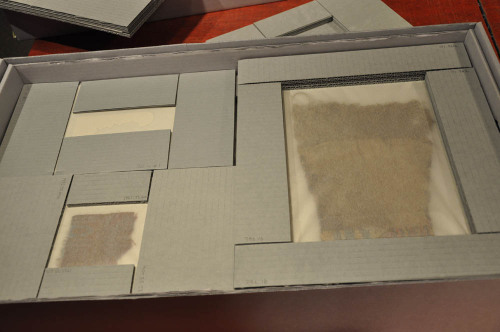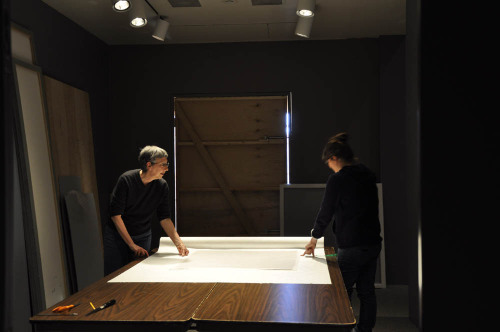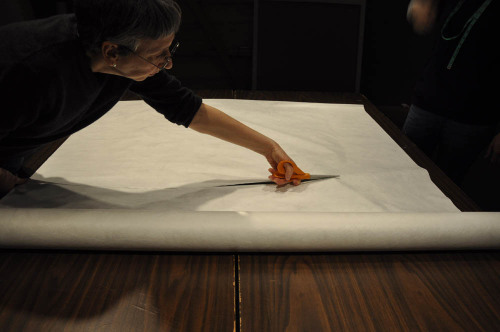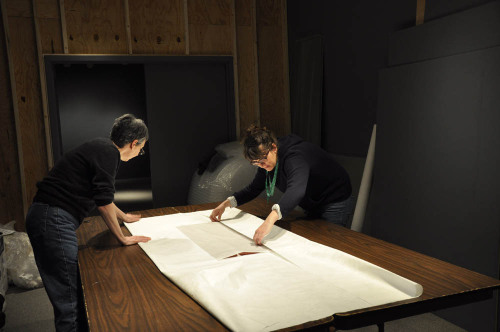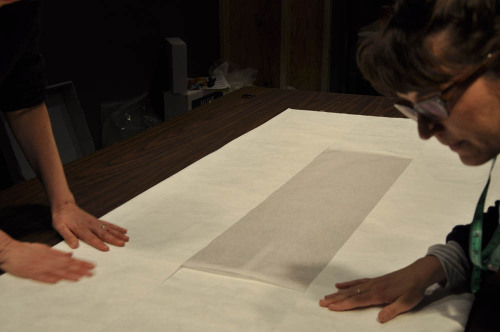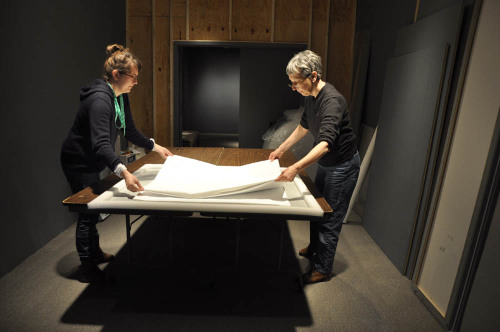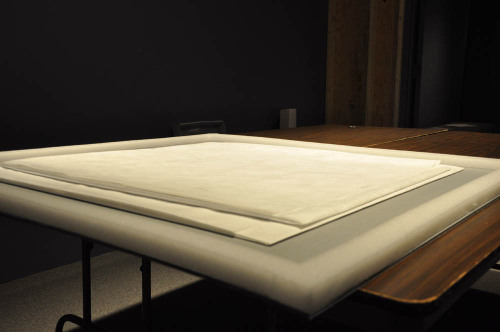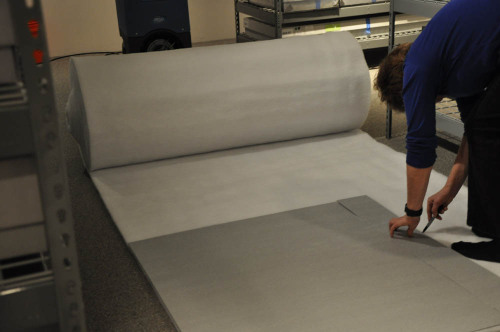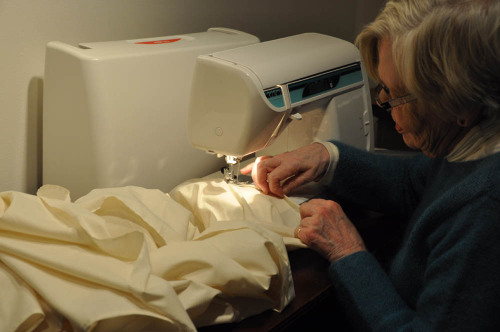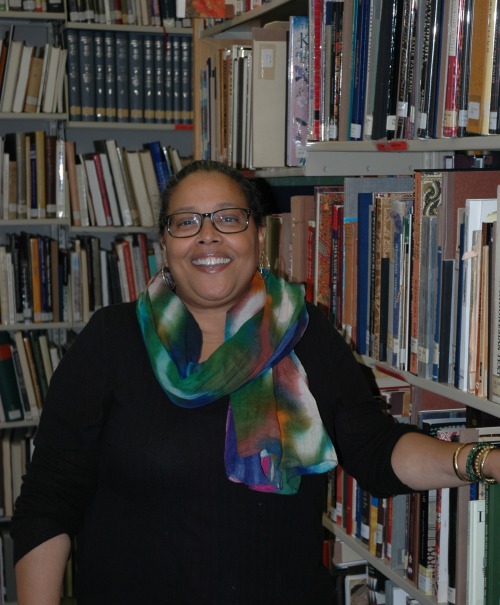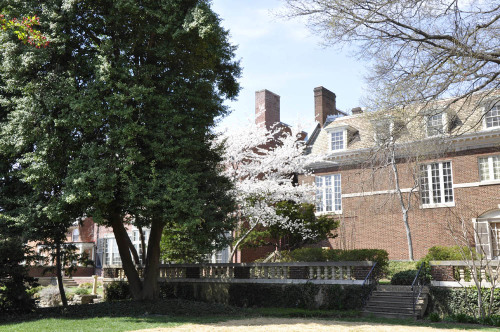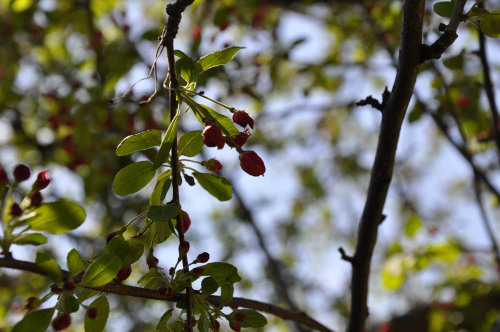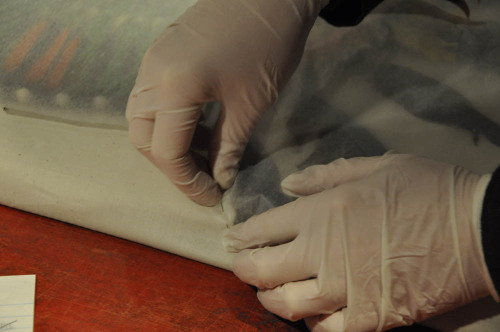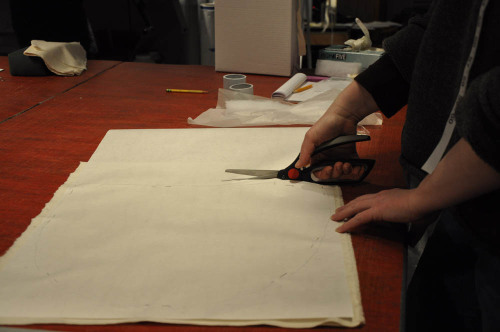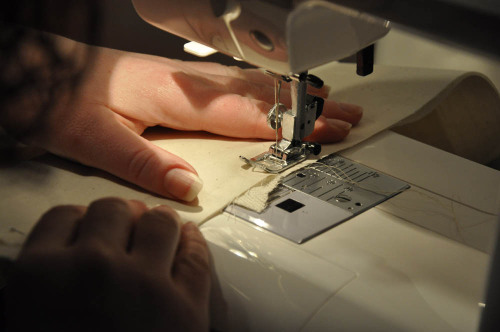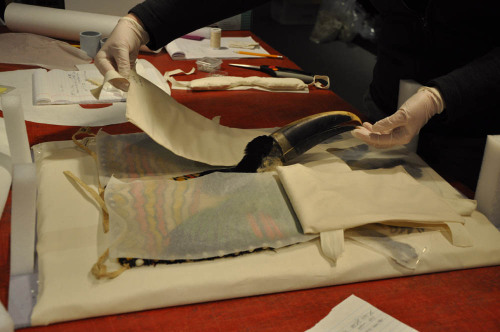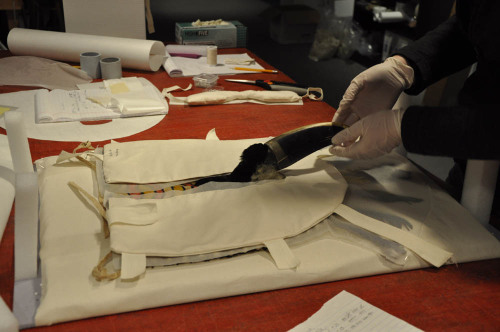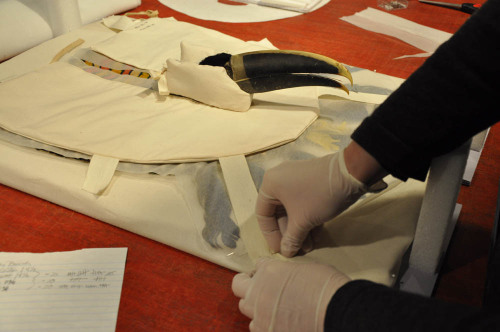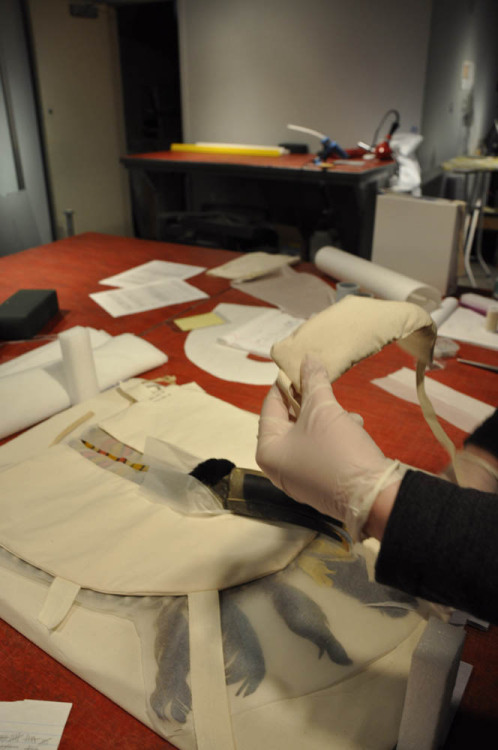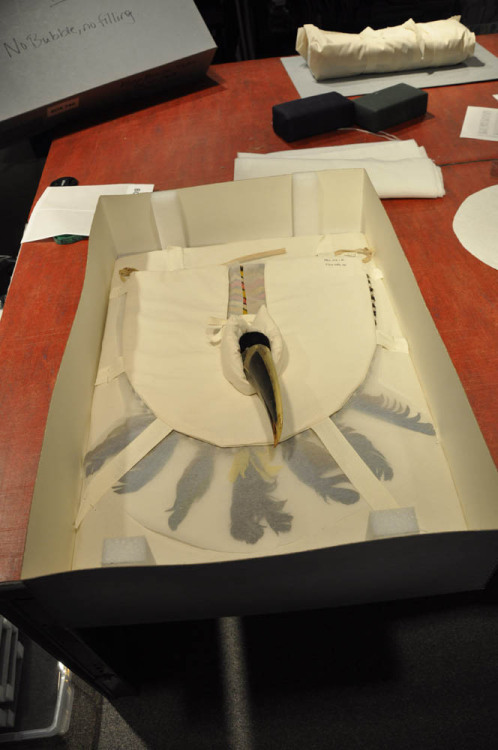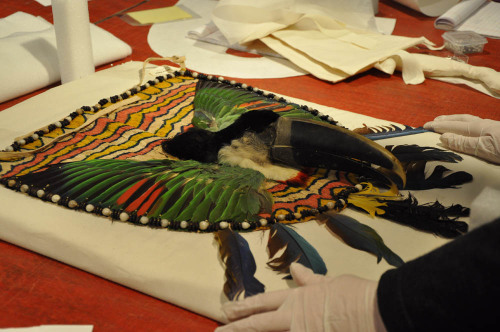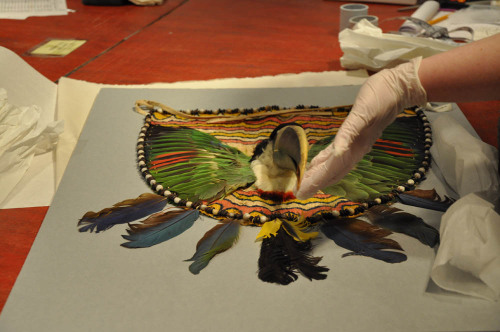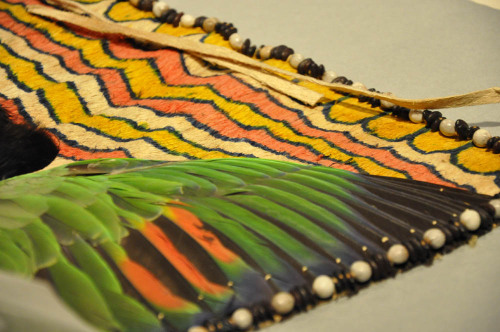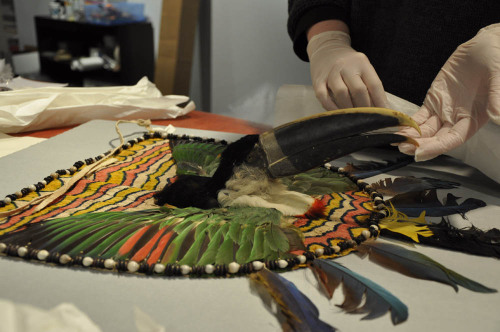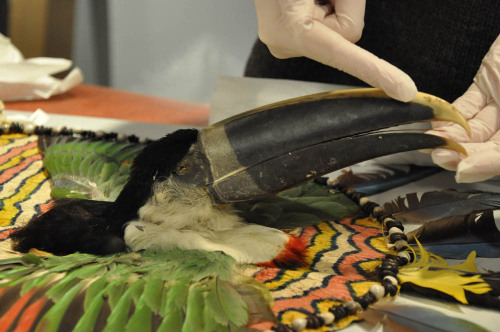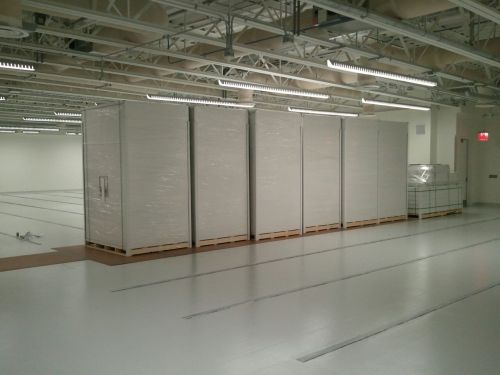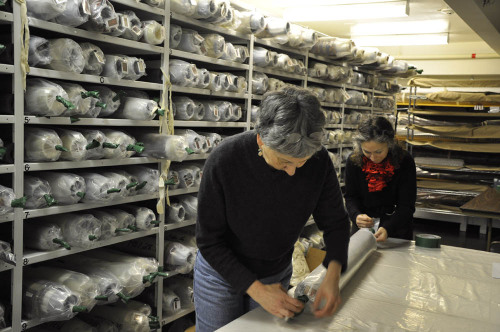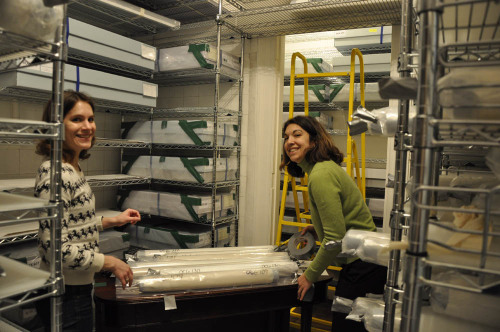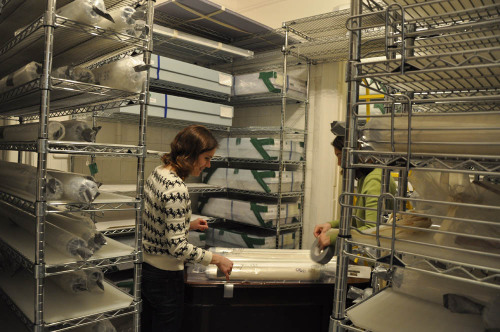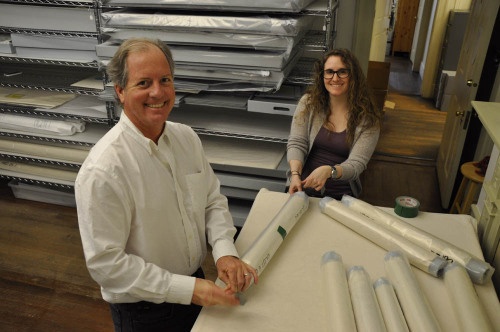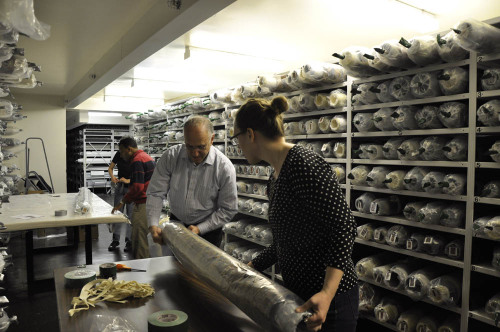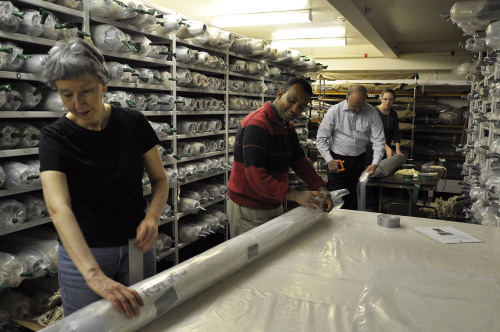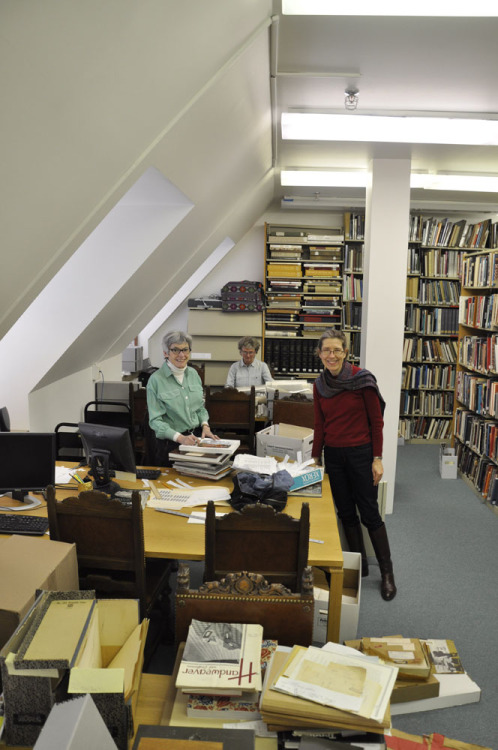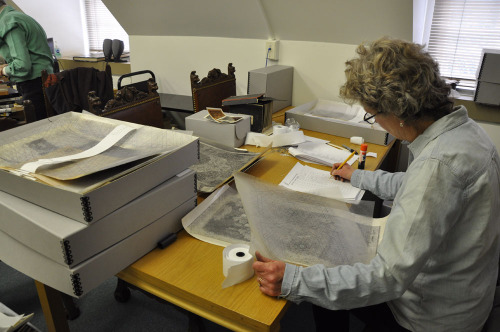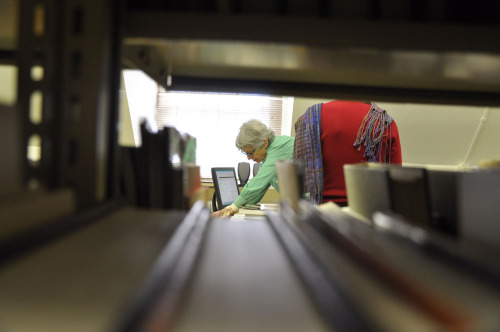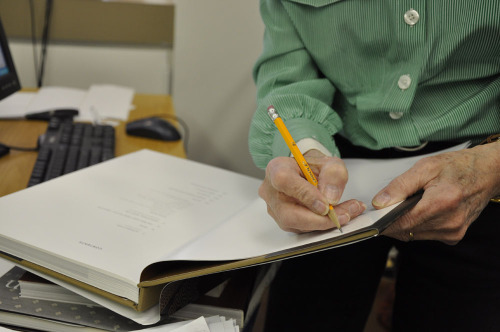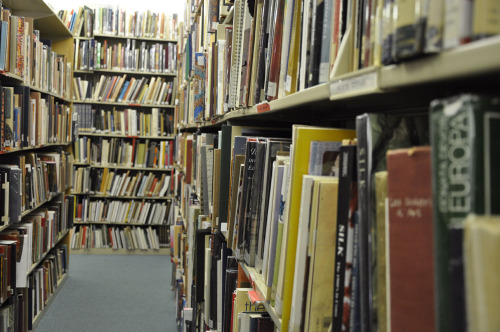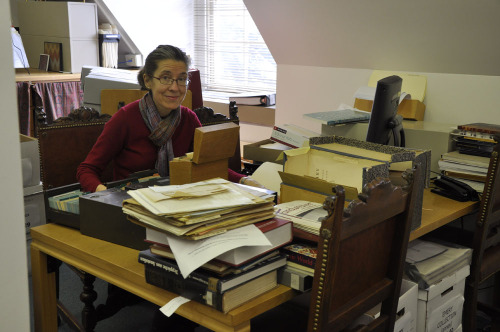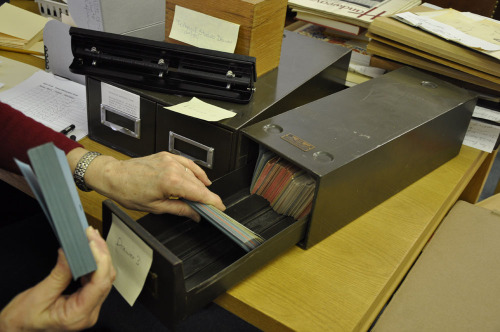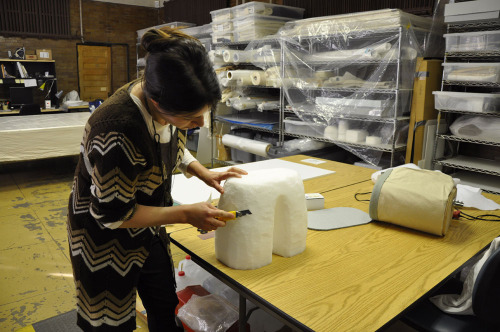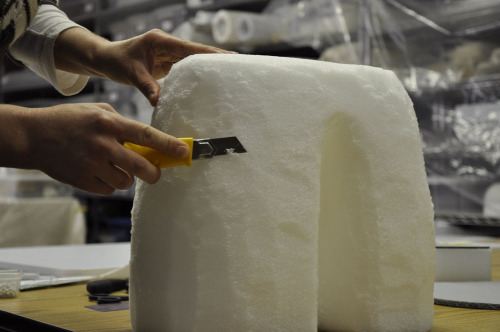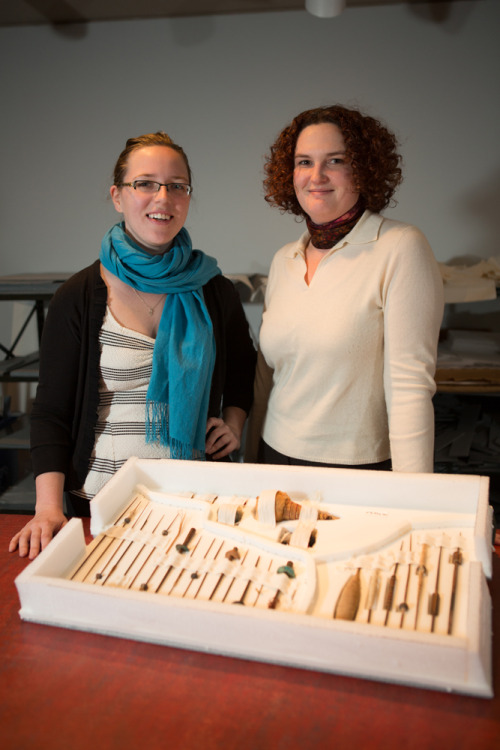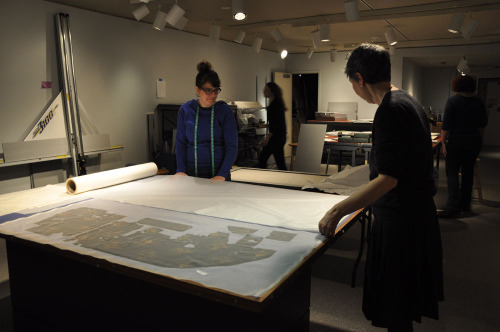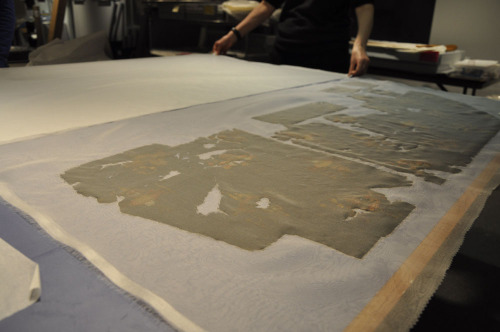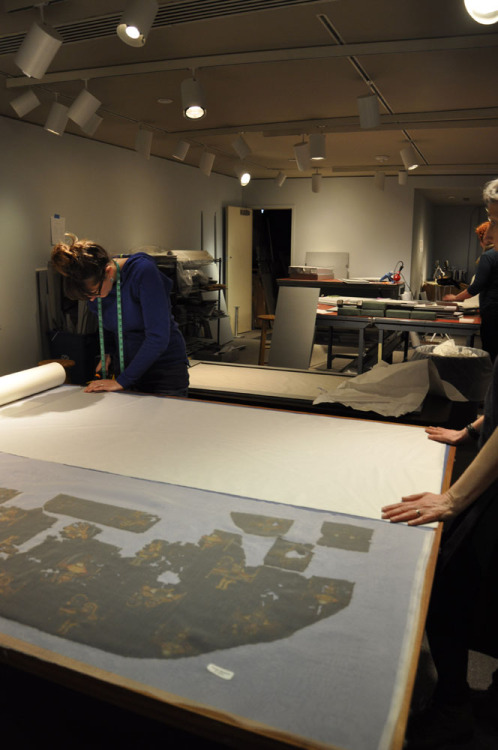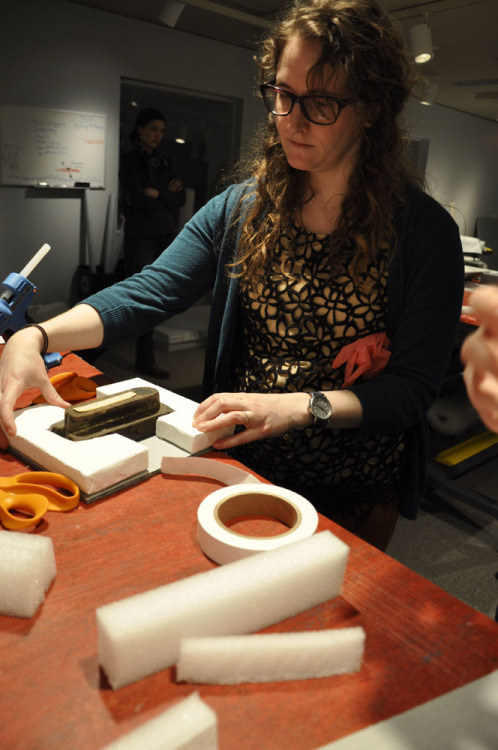#the textile museum
Rolled textiles comprise approximately one third of The Textile Museum’s collections in storage, so it is no surprise that our staff are so excited for an amazing upgrade to the way the museum cares for these important pieces.
At the conservation and collections resource center, rolled textiles can now be stored suspended on rods within adjustable bottomless drawers inside of cabinets. This method of storage has many advantages:
- By suspending the rolls on rods rather than resting them on a surface, we reduce the amount of stress on these fragile pieces.
- The drawers can be adjusted for any spacing, so both thicker and thinner rolls can easily find a home. The flexibility of these cabinets helps us efficiently use the cabinet space.
- The depth of the drawers (32 inches) allows up to 8 rolls to be suspended per drawer.
- The height of the cabinets (9 feet) maximizes vertical space.
In these photos, Registrar Rachel Shabica and Associate Registrar Tessa Lummis adjust the spacing of a rolled textile storage cabinet—from its factory setting to a new configuration that is more conducive to fitting a variety of roll circumferences.
Shabica and Lummis unscrew all of the drawers from the gliders that let them slide in and out of the cabinet, and then unscrew the gliders from the cabinet walls. Next, the registrars remove the gliders from the walls and reset them in an even spacing, utilizing the full height of the cabinet. Finally, they replace the drawers onto the moveable portion of the gliders and screw them back in place.
Configuring cabinets is a lot of hard work, but we could not be happier to have this upgraded storage system!
Post link
Just in time for the Washington, D.C. area’s first cold snap of 2015, museum staff have turned on the walk-through freezer at the conservation and collections resource center for an inaugural object freezing!
Here Chief Conservator Esther Méthé and Associate Registrar Tessa Lummis wheel in sixty-three objects that are part of a travelling exhibition, and therefore were not frozen as part of the collections move.
Freezing textiles at a temperature of -30 degrees Celsius or below is an important element of the museum’s integrated pest management protocol. After a week of freezing, these objects will be brought to room temperature before they are unwrapped, inspected, and put away in storage.
Post link
Staff from across the museum recently gave registrars and conservators a hand with the next phase of the collections move—unpacking The Textile Museum’s 19,988 pieces and storing them in their new home.
From left to right:
- Associate Conservator Maria Fusco (left) and Exhibition Coordinator Monika Hirschbichler (right) wrap archival boxes containing museum objects in polyethylene to prepare them for freezing in our new walk-through freezer!
- Curator Lee Talbot unpacks rolled textiles that have already been frozen. Talbot is unsealing them and trimming the tubular polyethylene so that the rolls can be threaded onto rods and placed in new custom-built cabinets.
- Museum Director John Wetenhall helps Registrar Rachel Shabica configure these storage cabinets, which were specifically designed to house The Textile Museum’s collections of rolled objects.
Post link
The Textile Museum has received three grants to support critical equipment needed to conserve textiles and mount exhibitions at its new facilities.
The Stockman Family Foundation Trust enabled the museum to purchase a conservation wash table (top) and suction system, used by conservators to gently clean collections pieces. Thanks to an in-kind donation from DeWalt, the museum received a shipment of power tools (bottom) that are essential in constructing exhibitions. Additionally, the Prince Charitable Trusts awarded funding through its capital grants program that allowed the museum to purchase bench and hand tools for its exhibition fabrication workshop.
Together these grants will increase staff efficiency and further best practices in collections care and exhibition fabrication.
Post link
The Collections Move Is Complete!
On November 11, museum staff oversaw the final delivery of The Textile Museum’s 19,988 collections pieces to the new conservation and collections resource center in Ashburn, Va. This monumental initiative began in January 2012 with a comprehensive survey of the collections. The effort continues as staff carefully unpack and place objects in new storage shelves and cabinets.
Congratulations to our dedicated staff and volunteers on this extraordinary achievement!
Post link
Meet Lori Kartchner!
The George Washington University Museum and The Textile Museum welcomes Lori Kartchner, who joined our staff on September 29 as assistant curator of education. Previously a contract educator for the museum’s partnership with the Boys and Girls Clubs of Greater Washington, Lori has also volunteered her time since September 2013 on the museum’s new Textile Learning Center project. Lori received her MAT from GW’s Museum Education Program in 2013 and her BA in Humanities: Art History from Brigham Young University in 2010.
Post link
Our exhibition production team is breaking in the workshop at our new conservation and collections resource center! New workshop tools were purchased through a generous grant from the Prince Charitable Trusts.
Here, Exhibition Production Manager Doug Anderson cuts boards that will be used to mount flat textiles in Unraveling Identity: Our Textiles, Our Stories, opening this March.
The team’s next project will be to construct furnishings for the two opening Washingtoniana exhibitions: including acrylic stands for photo displays, and bases to support the climate-controlled cases that will house fragile historic documents.
Post link
It really takes a team effort to safely pack some of the largest and most fragile objects in The Textile Museum’s collections. The Paracas mantle is one of these special pieces. Due to its delicate nature, it needed to travel flat (without being folded or rolled), which posed challenges for moving it through tight doorways.
Ely, Inc. art handler Chris Kirages addressed these challenges by creating a special crate which uses foam padding and gentle compression to protect the piece and prevent it from shifting, while allowing the crate to tilt through doorways when needed.
In the photos above, you can see art handlers and the museum’s conservation and collections staff removing the piece from an over-sized storage drawer and placing it on padding inside the crate. Art handlers removed the board by slowly pulling it away as others gently held the mantle in place. Once the piece was off of its storage board and inside the crate, it was covered in soft tissue sheets, and another board was placed on top. The crate was sealed by screwing slats across the top, thus creating the gentle compression that kept this Peruvian treasure safe in transit.
- Mantle, Peru, South Coast, Paracas style, ca. 600 BCE. Camelid fiber, 85 x 47 in. TM 91.192. Acquired by George Hewitt Myers in 1940.
Post link
Ely, Inc. art handler Chris Kirages recently packed The Textile Museum’s small collection of ceramics for safe transit to the museum’s new conservation and collections resource center.
First, Kirages used archival blue board, Ethafoam, and Volara to create individual mounts for each ceramic piece that will both protect these pieces during travel and permanently stabilize them in collections storage.
Next, he lined a large bin box with cushioning and foam bumpers. The ceramic mounts were placed between the bumpers in a single layer, with additional cushioning between and on top. The foam bumpers allowed Kirages to safely create multiple layers of ceramics in a single large box.
Post link
A total of 118 collections pieces that will be featured in The Textile Museum’s first exhibitions at its new location—Unraveling Identity: Our Textiles, Our Stories and China: Through the Lens of John Thomson (1968-1872)—have been safely transported to the Foggy Bottom museum, to undergo final conservation treatment and preparation for display.
Post link
Chief Conservator Esther Méthé is working on packing our small collection of textile fragments that are encased in glass. Méthé is creating bumper trays for these fragile pieces and covering them with bubble, to ensure they are cushioned for transit.
Post link
Visiting conservation scholar Anna Keruzec is creating trays for three-dimensional Pre-Columbian dolls.
She begins by laying the dolls on a tray-sized piece of paper and tracing them. Then, she cuts out tray-sized sheets of thin Ethafoam and a thicker piece of Volara. Anna uses the template she created to carve away the space of the dolls from the Volara, making a void for them to sit in. Next,, she glues the Ethafoam, then the Volara, to the blue board tray, and places the dolls in their niches and secures them with twill tape. Bumpers around the exterior of the trays allow multiple trays to stack in a box.
Now the pieces are stable and ready to travel!
Post link
Fun find! The collections management staff found this Mamiya C220 twin-lens camera among the photo archives equipment, complete with spare wide-angle and telephoto lenses!
Post link
Registration Technician Chelsea Hick is preparing Ethafoam and blue board trays to store and transport small three-dimensional objects.
Here, Chelsea wraps coiled bands in muslin, creates cubbies for each, and secures them in the trays with twill tape.
Post link
Check out this great Chimu-style loincloth and tunic. The macaw feathers and metal plaques are beautiful!
- Loincloth and tunic, Peru, Chimu style. Cotton, metal, feathers. TM 1962.9.4 and 1962.9.6.
Post link
Collections management intern Jennifer Torres and volunteer Elizabeth Campos are organizing and packing our photo archives, which contain digital and analog photographic material of Textile Museum collections objects.
Post link
Passive Mats (Part 3)
Now that the mat itself has been fabricated, it’s time to fill it! Here, collections management intern Christine Hogan cuts and and irons a piece of muslin that is the size of the base board, while intern Julia Grasso cuts out two pieces of tissue in the same size. The muslin will provide friction to prevent the tissue from slipping on the surface of the blue board.
Julia and Christine then place the object between the two pieces of tissue, using scrap board to support it. Next, they use scrap board to line up the object with the mat base board, and gently pull the board away, leaving the object and tissue aligned on the mat. Christine closes the flaps, ensuring that they do not come in contact with the object. Last, but certainly not least, they place the mat in an archival box so it can travel safely. Well done, ladies!
Post link
Passive Mats (Part 2)
In our last post, we explained what passive mats are, and why we are using them to store and transport fragile fragmentary textiles. Here, collections management interns Julia Grasso and Christine Hogan demonstrate the process from start to finish.
First, the textile must be measured. Based on their results, Julia and Christine determine that this piece needs the largest mat size for the selected box. They input the dimensions into a spreadsheet that calculates the hinging flap dimensions based on the size of textile and the size of the mat base board. Julia then cuts the base board and flaps, numbers each with the object number, and lines them up against the sides of the mat. Using Tyvek tape, she attaches the four flaps to the base board and ensures that they can independently hinge. The flaps of the mat are then opened to receive the internal elements of the mat.
Stay tuned to find out what happens next!
Post link
Passive Mats (Part 1)
The Textile Museum has a large collection of very fragile, flat archaeological fragments, some of which live in drawers and cabinets without any storage supports. In order to transport these textiles safely, our conservation department has prioritized housing them in new passive mats.
Made of archival blue board, the passive mat is a storage-specific mount with independently hinging sides that holds small, flat textiles. The object is protected between two pieces of archival tissue and passively held in place by the sides of the mat—which keep the object from shifting in storage or during transit without putting pressure on it. Because the sides are thicker than the textiles, the mats can be stacked on top of each other without any risk of contact.
Our passive mats are created in standard base sizes for three different box sizes (above), so they “puzzle piece” together inside a box—preventing the mats from sliding and shifting during transit. Some mats take up a whole layer, while others fill halves or quarters.
These mounts will not only keep objects safe for the move, they will ensure the pieces are easily accessible for staff and researchers in the future.
Stay tuned to find out how we construct these mounts!
Post link
Chief Conservator Esther Méthé and conservation intern Annaïck Keruzec are rehousing our oversize textiles. To accommodate these challenging pieces—which must remain flat, but are too large for our standard-size boxes—Méthé has designed stack-able, oversize trays of archival blue board with Ethafoam bumpers.
Méthé and Keruzec wrap the objects in Tyvek, then place them in these trays, while conservation volunteers Barbara Gentile and Julie Evans create muslin pillows. The pillows will fill the trays, applying gentle pressure to the objects when the trays are stacked and preventing the pieces from shifting in transit. While Gentile cuts the batting, Evans sews the muslin.
Post link
Meet Shelia Freeman!
If you have paid a visit to The Textile Museum in the past nineteen years, you probably know (and love) Sheila Freeman. For nearly two decades, Sheila has eagerly welcomed visitors at our front desk and worked tirelessly on TM membership. In her early career, Sheila never pictured herself working at a museum, but she admits, “I have always loved textiles [and] have been fortunate to meet so many different and exciting people.” Sheila is especially drawn to African and Indian textiles in the museum’s collections. In her spare-time, she hand-crafts her own textile creations—soft sculpture dolls for family and friends.
Post link
How to Pack Your Toucan! (Part 2)
After placing the toucan apron on its pillow, Associate Conservator Angela Duckwall covers it with a piece of unbuffered tissue, cut in a yoke shape to fit. She pins the outer edges of the tissue to the pillow to keep the feathers in place. Next, she creates a muslin and batting bib to cover the majority of the apron, again in a yoke shape to allow for easy placement and removal. This bib has straps that are pinned down to the pillow to secure the whole unit to the base board. Finally, the neck of the toucan was in need of support: Duckwall created a support collar of batting and muslin that cradles the head of the toucan, alleviating stress on the neck.
He’s ready for his big move! Great job, Angela!
- Apron, Ecuador, early 20th century. Bark cloth, feathers, beak, beads.TM 1966.23.1A. Museum Purchase.
Post link
How to Pack Your Toucan! (Part 1)
Associate Conservator Angela Duckwall had an unusual task this week: to stabilize and pack a Ecuadorian bark cloth apron, complete with a toucan head (yes, that’s a real head, folks!) and macaw and parrot feathers! Can you believe this apron is just one piece of an equally impressive ensemble?
First, Duckwall created a muslin pillow for the apron to rest on. Next, she cut an archival base board to fit the internal dimensions of the box. She glued Ethafoam posts to the board that are slightly taller than the box. When the lid is placed on the box, it will place pressure on the Ethafoam, keeping the base board and object from shifting.
Stay tuned for our next steps in packing this gorgeous toucan apron!
- Apron, Ecuador, early 20th century. Bark cloth, feathers, beak, beads.TM 1966.23.1A. Museum Purchase.
Post link
New storage cabinets have arrived at the museum’s recently completed conservation and collections resource center in Ashburn, VA!
Post link
Recently some of The Textile Museum’s non-collections staff members lent a hand preparing our rolled textiles for freezing prior to their move to the new conservation and collections resource center in Ashburn!
Thanks so much to Senior Curator Sumru Belger Krody, Communications and Marketing Associate Chita Middleton, Director John Wetenhall, Chief Financial and Administrative Officer Doug Maas, and Accounting Associate Kibebew Wondriad.
Post link
As The Textile Museum prepares to move the Arthur D. Jenkins Library of Textile Arts, volunteers (from left to right) Susan Dichter, Gayle Gibbons, and Margaret Yamamoto work diligently to label books, assess and rehouse photographs, and catalog archival material. The library will reopen with the new museum at the George Washington University in late fall 2014.
Post link
Associate Conservator Maria Fusco is carving archival ethafoam to make the base for a hip form. This hip form will be used to display a sarong from Indonesia in The Textile Museum’s first exhibition at its new location at the George Washington University, Unraveling Identity: Our Textiles, Our Stories.
Post link
Meet Our Team!
Chelsea Hick and Angela Duckwall have spent countless hours preparing and packing The Textile Museum’s collections to move to the George Washington University. Get to know this dedicated duo, and stay tuned for future posts featuring other members of our TM team.
Chelsea (left) grew up in Connecticut and Florida and began work at The Textile Museum in 2010 as a part-time receptionist. Now the museum’s registration technician, Chelsea helps solve challenging collections rehousing projects. In her time off, she’s often working at a local foods market or exploring Washington, D.C. with her film camera.
An Indiana native graduate of the University of Delaware’s art conservation master’s program, and former TM intern, Angela (right) has been an associate conservator at The TM for two years, focused on the collections move. An avid knitter and cook, she has baked many tasty treats for the staff’s monthly “Cake Day.”
- Spindles, implements, yarns, and fiber, Peru. TM N91.45A-DD. Acquired by George Hewitt Myers. Photo by William Atkins / The George Washington University.
Post link
Chief Conservator Esther Méthé supervises conservation intern Annaïck Keruzec as she cuts tissue for a custom mount. The mount will help secure a very fragile oversize fragment that Méthé and Keruzec have encased in silk crepeline for stabilization.
- Mantle fragments, Peru, south coast, Paracus. TM 91.337A. Acquired by George Hewitt Myers in 1941.
Post link
Registration Technician Chelsea Hick and Assistant Registrar Tessa Lummis are assembling three-dimensional mounts to house wooden printing blocks. These mounts are made from archival blue board and ethafoam covered in Tyvek. Archival hot glue secures the foam, and twill tape is used for the handles.
- Printing block, India. Wood. TM 1970.29.14. Textile Museum Membership Purchase.
Post link



